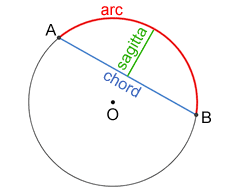Math Is Fun Forum
You are not logged in.
- Topics: Active | Unanswered
Pages: 1
#1 2024-08-10 21:55:58
- Jai Ganesh
- Administrator

- Registered: 2005-06-28
- Posts: 48,424
Sagitta (Geometry)
Sagitta (Geometry)
Gist
In geometry, the sagitta (sometimes abbreviated as sag) of a circular arc is the distance from the midpoint of the arc to the midpoint of its chord.
The distance from a point in a curve to the chord; also, the versed sine of an arc; so called from its resemblance to an arrow resting on the bow and string.
Details
In geometry, the sagitta (sometimes abbreviated as sag) of a circular arc is the distance from the midpoint of the arc to the midpoint of its chord. It is used extensively in architecture when calculating the arc necessary to span a certain height and distance and also in optics where it is used to find the depth of a spherical mirror or lens. The name comes directly from Latin sagitta, meaning an "arrow".
Formulas
In the following equations, s denotes the sagitta (the depth or height of the arc), r equals the radius of the circle, and l the length of the chord spanning the base of the arc. As
and are two sides of a right triangle with r as the hypotenuse, the Pythagorean theorem gives us.The sagitta may also be calculated from the versine function, for an arc that spans an angle of
Approximation
When the sagitta is small in comparison to the radius, it may be approximated by the formula
Alternatively, if the sagitta is small and the sagitta, radius, and chord length are known, they may be used to estimate the arc length by the formula
where a is the length of the arc; this formula was known to the Chinese mathematician Shen Kuo, and a more accurate formula also involving the sagitta was developed two centuries later by Guo Shoujing.

 .
.
It appears to me that if one wants to make progress in mathematics, one should study the masters and not the pupils. - Niels Henrik Abel.
Nothing is better than reading and gaining more and more knowledge - Stephen William Hawking.
Offline
Pages: 1